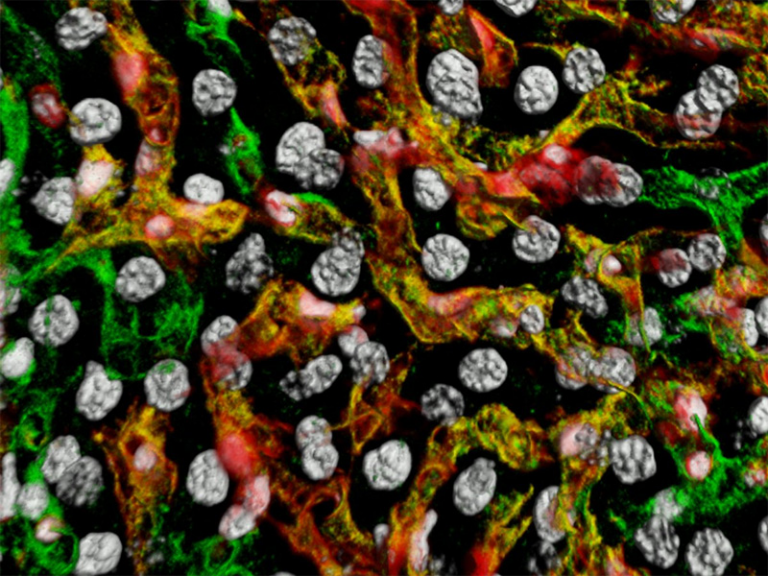Elusive stem cells could help repair blood vessels
27 September 2018
A unique source of stem cells in blood helps to build blood vessels according to new UCL-led research with mouse embryos

The findings, published in Nature, change scientific understanding of how blood vessels are made and bring scientists one step closer to using stem cells to grow new blood vessels and repair damaged ones.
Growing and repairing blood vessels is a major goal in treating heart and circulatory diseases in which vessels become damaged, including, for example, coronary heart disease and peripheral arterial disease or some blinding eye diseases.
Until now, scientists thought that new blood vessels in the embryo only grew when existing blood vessel cells divided. The new research shows that stem cells in the bloodstream can develop into endothelial cells – important cells which line all blood vessels.
“These stem cells were previously known to form blood and immune system cells in the foetus. To find that they also generate endothelial cells for new blood vessels in the foetus was unexpected and is hugely exciting,” said lead author Professor Christiana Ruhrberg (UCL Institute of Ophthalmology).
“Our findings may pave the way to resolve a long-standing debate in the scientific community as to whether blood stem cells could be used to promote endothelial regeneration in patients with poor blood supply in their hearts or other organs.”
Stem cells are cells which can differentiate into mature cell types. For decades, researchers have been searching for stem cells in the blood that can develop into endothelial cells, coined ‘endothelial progenitor cells’ because of their potential in regenerative medicine. So far, scientists have disagreed about what they are and what they look like, and whether they truly exist in the blood.
This study provides important new evidence that such a stem cell exists in the blood stream of developing embryos. An important next step will be to track these cells down in humans.
The researchers used fluorescent tags to follow the fate of the stem cells, called erythromyeloid progenitors (EMPs), already known to develop into red blood cells and certain types of immune cells. EMP stem cells grown in a dish developed into endothelial cells as well as red blood cells and immune cells. The EMP stem cells also developed into endothelial cells in mice that were naturally growing in their mother’s womb, and they continued to line blood vessels into adulthood.
“Further research is needed to find out exactly how EMPs and their endothelial cell offspring work and whether they might be used in regenerative medicine. It will also be important to figure out if these cells actively contribute to making new endothelial cells throughout life,” said co-author Dr Alice Plein (UCL Institute of Ophthalmology).
“We initially discovered the EMP origin of endothelial cells in the brain when observing brain-resident immune cells. In a further twist, we found that they also lined more than half of the liver vasculature all the way into adulthood,” added co-author Dr Alessandro Fantin (UCL Institute of Ophthalmology).
The research was funded by the British Heart Foundation, Wellcome and the Medical Research Council.
“Using stem cells to treat patients with heart and circulatory disease has huge potential. But taking positive findings from the lab to patients has often been very challenging,” commented Professor Metin Avkiran, Associate Medical Director at the British Heart Foundation.
“Getting these fundamentals right is essential for finding stem cell treatments which will work in patients. These findings could pave the way to new discoveries in regenerative medicine and allow scientists in the future to grow new blood vessels and repair those that are damaged in many forms of heart and circulatory disease.”
Links
- Research paper in Nature
- Professor Christiana Ruhrberg's academic profile
- Ruhrberg lab website
- UCL Institute of Ophthalmology
Image
- Primitive stem cells in the embryonic blood contribute cells to the inner lining of blood vessels. In this image of foetal liver, the blood vessel lining that originates from blood stem cells is shown in red, whereas pre-existing blood vessel lining is shown in green. The nuclei of all liver cells are shown in white. Image courtesy of Dr Alessandro Fantin, Ruhrberg lab.
Source
Media contact
Chris Lane
Tel: +44 (0)20 7679 9222
Email: chris.lane [at] ucl.ac.uk
 Close
Close

